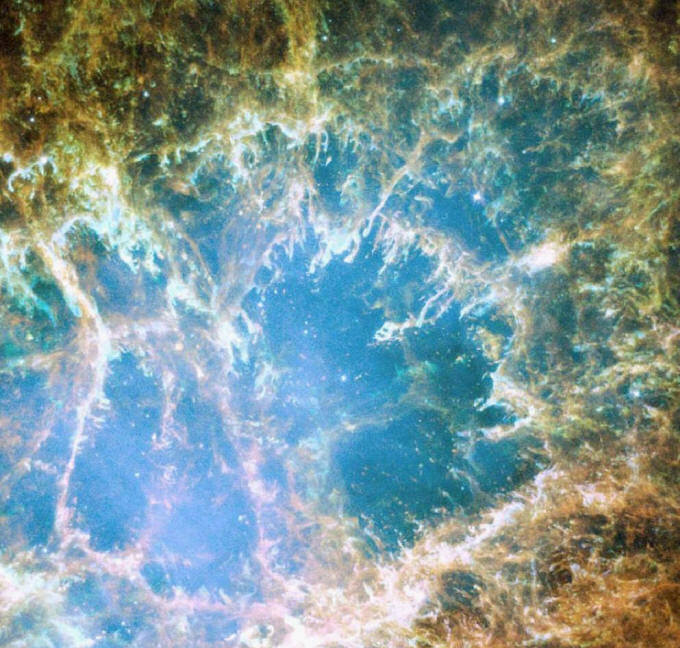|
|
Pulsar Convolutions
Nov
04, 2009
Can stars rotate faster than a
power tool?
On June 11, 2008, NASA launched the
Fermi Gamma Ray Space Telescope
(formerly
GLAST) on a mission to map
extremely high frequency
electromagnetic energy across the
sky. Although gamma rays are said to
travel up to billions of light-years
through space, they are unable to
penetrate Earth's upper atmosphere,
so Fermi is in an orbit outside the
regions of greatest density.
According to a recent
press release, scientists from
the University of California Santa
Cruz Institute for Particle Physics
have been able to identify 16 new
pulsars using the signature of their
gamma ray emissions alone. In the
past, pulsars were usually
discovered by monitoring radio
waves, whereas Fermi has found what
have been deemed "radio quiet"
pulsars.
Prevailing theories of stellar
evolution describe pulsars as
neutron stars that are rotating at
high speeds. A neutron star is
theorized to form when a star
eventually collapses at the end of
its life cycle, no longer able to
resist the gravitational forces that
draw it down into its own center. As
the star contracts, it spins faster
and faster, similar to what happens
when an ice skater's arms are drawn
in close: angular momentum
increases, resulting in faster
rotation.
The magnetic field surrounding a
neutron star is said to become
focused at each pole until an
intense, narrow beam of radio waves
shines out from the poles like twin
beams of a lighthouse. If the beams
are not pointed directly at Earth,
they are not detected. Consensus
opinions assume that there is a
large population of neutron stars in
the galaxy, so an assumed population
of radio-quiet pulsars must also
exist.
A neutron star is so compressed that
all the electrons have been crushed
into the nuclei, combining with the
protons to form neutrons. The
neutrons are then packed so tightly
that the empty space between
particles is also eliminated. The
intense magnetic and electric fields
surrounding pulsars are supposed to
accelerate charged particles to near
light speed, and it is those
particles that generate gamma ray
emissions.
The Crab Nebula pulses 30 times per
second. That means the star rotates
30 times per second, but there are
pulsars with frequencies of 716
hertz. The forces generated when
billions of megatons spin as fast as
a power drill means that the stars
should tear themselves apart, except
enough mass is added to the theory
for gravity to hold it together.
Another possibility, one not
considered by contemporary
astrophysicists, is that
electrical oscillations are
causing the rapid flicker of
pulsars. The regular frequency is
not mechanically generated. Instead,
it is the capacitive, resistive and
inductive electrical environment
around the star. Compacted matter
and extreme rotation are not
necessary. Electricity traveling
through circuits provides a coherent
explanation that is consistent with
commonly accepted electromagnetic
theories, as well as with laboratory
experiments.
Stephen Smith
|
|
|
|
|
|
SPECIAL NOTE - **New Volumes Available:
We are pleased to announce a new
e-book series
THE UNIVERSE ELECTRIC. Available now, the first volume
of this series, titled Big Bang, summarizes the failure of modern cosmology
and offers a new electrical perspective on the cosmos. At
over 200 pages, and
designed for broadest public appeal, it combines spectacular
full-color graphics with lean and readily understandable
text.
**Then second and third volumes in the series are now available,
respectively titled Sun and Comet, they offer
the reader easy to understand explanations of how and why these bodies
exist within an Electric Universe.
High school and college students--and teachers in
numerous fields--will love these books. So will a large
audience of general readers.
Visitors to the Thunderbolts.info site have often
wondered whether they could fully appreciate the Electric
Universe without further formal education. The answer is
given by these exquisitely designed books. Readers from
virtually all backgrounds and education levels will find them
easy to comprehend, from start to finish.
For the Thunderbolts Project, this series is a milestone.
Please see for yourself by checking out the new
Thunderbolts Project website, our leading edge in
reaching new markets globally.
Please visit our
Forum
|
|
|
|
|
|
|
|







